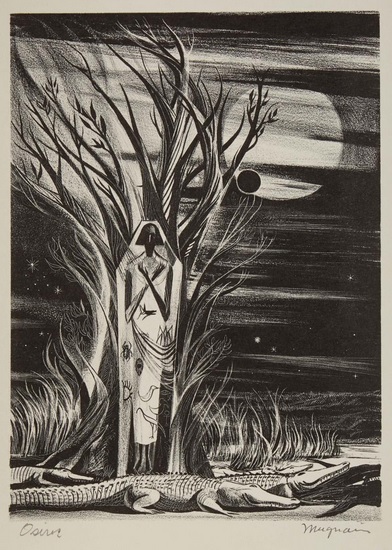
Joseph Anthony Mugnaini
American, 1912-1992
Osiris, 1958
lithograph
8 5/8 × 6 1/4 in.
SBMA, Gift of Mary and Will Richeson, Jr.
2017.17.1.4

Joseph Mugnaini - undated photo
"I will never forget the bristling energy and vitality of Joseph Mugnaini. I can still see him, scowling amiably at me from beneath his hat brim, bursting into hearty laughter and expostulations as he as he talked. His hands were always in motion, and after finding some note paper in my hotel room, he happily scrawled away, the restless lines dashing and skittering across the surface in quick, rapier-like jabs and thrusts. He seemed to be conducting with the pen, as an orchestra leader would gesture and cajole sounds from his players. His dynamic lines seemed to gather themselves of their own accord into forms which coalesced into living images." - John C. Tibbetts
COMMENTS
Joseph Anthony Mugnaini, painter, printmaker, author, illustrator, and educator, was born Giuseppe Mugnaini in Viareggio, Tuscany, Italy, on 12 July 1912. Shortly after his birth his family emigrated to the United States and settled in Riverside, California. Eleven years later they moved to Los Angeles and, in 1941, Mugnaini became a naturalized citizen.
He attended the Otis Art Institute in Los Angeles from 1940 to 1942, before serving the U.S. Army during World War II. After his discharge, Mugnaini returned to Otis Art Institute on the G.I. Bill and three months later he joined the faculty of Otis where he eventually became head of the Drawing Department. He retired in 1976.
Author of five books on art techniques and materials, he is best known as being the primary illustrator of the science fiction books of Ray Bradbury. Mugnaini earned an Academy Award nomination and the Golden Eagle Award for his paintings for the film Icarus, a Bradbury collaboration.
Mugnaini was a member of and exhibited with the Painters and Sculptors of Los Angeles, the Los Angeles Art Association, the Glendale Art Association, and the Society of American Graphic Artists. He exhibited at the Los Angeles Public Library, 1947; Chabot Gallery, 1949; Compton Art Center, 1951; Los Angeles County Museum of Art, 1951; Pasadena Art Institute, 1954 (solo); Sierra Madre Public Library, 1959 (solo); and Orange Coast College, Costa Mesa, 1974 (solo). Mugnaini's work was included in the annual National Exhibition of Prints at the Library of Congress and he was awarded the Pennell Prize three years in a row. His works are in the collections of British Museum; Los Angeles County Museum of Art; Norton Simon Museum, Pasadena; University of Hawaii; Temple University, Philadelphia; and the Library of Congress,
Washington, D.C.
- © The Annex Galleries, Santa Rosa, CA
Although respected for accomplishments in other areas, Mugnaini is best known for his long association with Ray Bradbury, who regarded him as both a friend and the best interpreter of his work. As a result, he did the covers and interior art for several first editions of Bradbury's works, as well as related projects like illustrations for a 1962 cartoon adaptation of Bradbury's story "Icarus Montgolfier Wright" (May 1956 F&SF) and the cover for the May 1963 "Ray Bradbury" issue of The Magazine of Fantasy and Science Fiction – a painting of Bradbury flanked by iconic images from his stories that was later reused as the cover for Jerry Weist's Ray Bradbury: An Illustrated Life (2002).
Mugnaini's first Bradbury painting is probably his most famous – an image of a grieving man, dressed in newsprint and surrounded by flames, that graced the cover of the first edition of Bradbury's Fahrenheit 451 (1953) and has reappeared on several later editions, most recently a 2012 trade paperback edition. Other memorable efforts for Bradbury books include his painting of an old woman walking with a lizard past a series of tall houses for The October Country (1956), playful renderings of containers of medicine for A Medicine for Melancholy (1959), and an elaborately decorated number "22" on a barren field with dead trees for the omnibus Twice 22 (1966).
For many, Mugnaini's trademark style – an elongated human figure against a minimal or symbolic background – is indelibly linked with Bradbury's fiction, explaining why his covers and interior art are still being used for recent editions of his works. Still, it should also be remembered that Mugnaini did provide evocative covers for a few books by other genre writers, including Robert Crane's Hero's Walk (1954), Theodore Sturgeon's A Touch of Strange (coll 1958), and Louis Charbonneau's No Place on Earth (1958). In his later years, Mugnaini focused more on writing instructional art books, although he did publish a compilation of his artwork in 1982, featuring a foreword by his greatest admirer, Ray Bradbury. [GW]
- Encyclopedia of Science Fiction, November 20, 2020
http://www.sf-encyclopedia.com/entry/mugnaini_joe
